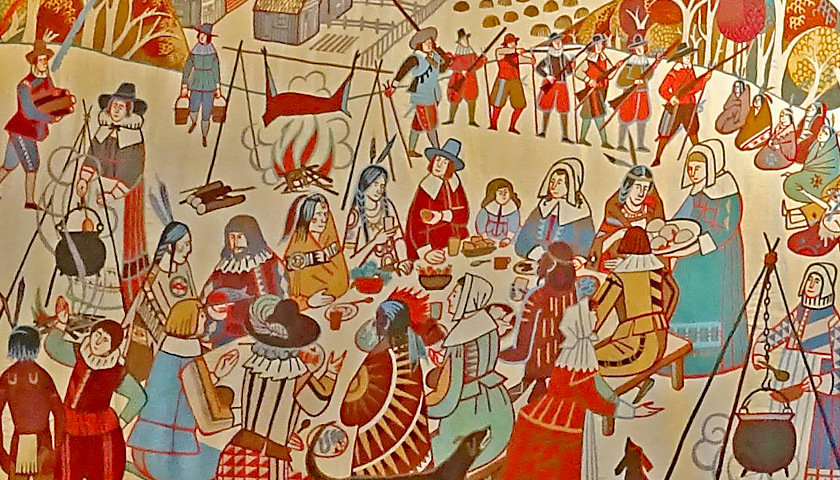A Minneapolis church voted Sunday to indefinitely remove a “disturbing and hurtful” embroidery depicting the first Thanksgiving.
The Plymouth Congregational Church has been debating the appropriateness of the embroidery and three others like it for several months. Church leaders drafted a “Plymouth Leadership Council Embroideries Action Plan” and presented it to congregants in May.
“Many of us have brought visitors to Plymouth to see these amazing pieces of art. Yet, over the past several months, Plymouth members have been called to pay attention—some for the first time—to images in the embroideries that are disturbing and hurtful to many people, particularly those outside of the white-dominated mainstream,” the action plan states.
The embroideries are part of a seasonal series created by the “Plymouth Needlers” between 1968 and 2012, the most controversial of which is called “Churchmen in the New World” (a detail of the work is pictured above). The piece of art depicts Pilgrims and Native Americans sharing a meal while others are carried away to a slave ship.
After months of discussion, church members voted 561-372 to indefinitely remove the embroidery from the church, according to The Star Tribune.
Church leadership plans to temporarily display the other three embroideries throughout the year while it assesses next steps, the action plan states.
 “As a historically white congregation, Plymouth still has much to learn about our church’s and our collective American history from the points of view of other seekers of God,” reads the document. “Some images in the embroideries, while designed and created with exemplary artistry and loving intentions, celebrate interpretations of American history from the point of view of our white-dominated culture without a broader appreciation of and respect for the diverse cultures that comprise the American experience.”
“As a historically white congregation, Plymouth still has much to learn about our church’s and our collective American history from the points of view of other seekers of God,” reads the document. “Some images in the embroideries, while designed and created with exemplary artistry and loving intentions, celebrate interpretations of American history from the point of view of our white-dominated culture without a broader appreciation of and respect for the diverse cultures that comprise the American experience.”
Some congregants requested a “special meeting of the congregation” to propose an “alternative action plan.” Their proposal, which was rejected, recommended displaying the four embroideries “in the same sequence and for the same time frames as they have historically been displayed,” but called for installing information panels with “words of repentance acknowledging our history and how we are and will work to repair this harm.”
The alternative plan also suggested a lecture series, educational programming, discussion groups, new art exhibits and other activities designed to, among other things, “explore how our white privilege is reflected in our past and impacts our perspective and actions today.”
 Church leaders responded to the alternative action plan in a joint statement in which they declined to endorse the suggestions.
Church leaders responded to the alternative action plan in a joint statement in which they declined to endorse the suggestions.
“Imagery in the Churchmen in the New World embroidery has unintentionally caused pain and acts as a trigger for familial and historical trauma for some members of our congregation and members of our broader community,” they said in their response. “In order to ‘seek truth, justice and reconciliation,’ we want to curtail things that trigger trauma in others.”
The church planned a “special reflective worship service” for Monday night so its members could process the “plethora of emotions” that “are certain to be felt.”
In a similar act of self-censorship, Lt. Gov. Peggy Flanagan covered a number of controversial paintings in the Minnesota Capitol’s transition offices in November 2018 because of their “insensitive” and “historically inaccurate” depictions of Native Americans. A few weeks later, the St. Paul City Council moved to commission new murals for its chambers to replace the “very white and very male” artwork.
– – –
Anthony Gockowski is managing editor of Battleground State News, The Ohio Star, and The Minnesota Sun. Follow Anthony on Twitter. Email tips to [email protected].
Photos “Churchmen in the New World,” along with additional embroidery works by Plymouth Congregational Church.





“Feelings” trump reality and historical facts that apparently “trigger” the new generations. Let’s just extend this to all (most) of the illustrations associated with Christianity while we are at it. Yes, slaves were transported across the oceans on ships. Did you transport slaves? Did your parents or grandparents? “Feelings”